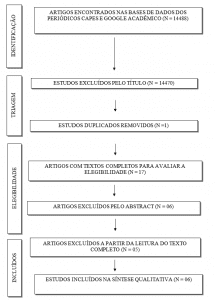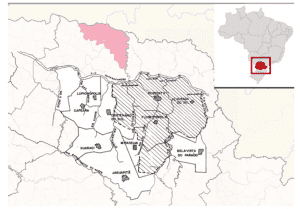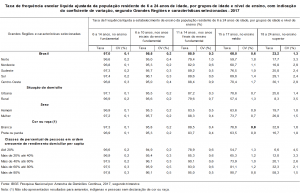ORIGINAL ARTICLE
ARAÚJO, Gizelda Rodrigues de [1], FREITAS, Josiane Machado Fagundes [2], SOUZA, Nayara Aryan Melo [3]
ARAÚJO, Gizelda Rodrigues de. FREITAS, Josiane Machado Fagundes. SOUZA, Nayara Aryan Melo. The historical role of women’s insertion in the labor market and their double shift. Revista Científica Multidisciplinar Núcleo do Conhecimento. Year 06, Ed. 11, Vol. 04, p. 76-97. November 2021. ISSN: 2448-0959, Access link: https://www.nucleodoconhecimento.com.br/history/womens-insertion, DOI: 10.32749/nucleodoconhecimento.com.br/history/womens-insertion
ABSTRACT
This study aims to understand the historical role of female participation in the labor market, as well as the articulation between domestic and paid work. The starting point was the following question: how are the relations between gender inequalities and the difficulties of women in the articulation between domestic work and paid work established? In this way, this research is justified by the observance of the reality regarding the double shift, or even triple shift, of Uruaçu women, in which the concomitant of paid work with domestic chores is verified, and in many cases, still, the study . The article in question is a field research and an exploratory bibliographic research, developed with a sample of 50 women, in the urban area of Uruaçu, chosen at random, through a questionnaire of 16 questions, objective and subjective. , with the purpose of investigating whether Uruaçu women also share this double journey. It is concluded, then, that greater investments in public policies are necessary in order to guarantee labor valorization, even in terms of social security rights, since this number of hours worked by women are not accounted for for retirement purposes.
Keywords: Woman, gender, double shift, rights.
1. INTRODUCTION
The historical legacy of colonization and economic development based on slavery and the exploitation of the black population, added to a patriarchal culture experienced since the beginning, in which the head of the house was always superior to the woman, makes possible a phenomenon invisible to public policies: the double woman’s workday.
Even in the face of so many changes that have taken place in the 21st century, such as economic, political, technological and social changes and through some significant changes in the female condition, such as the increase in schooling, the decrease in family size, entry and permanence in the labor market and the increase in households headed by women, even so, one of the points of greatest tension in the lives of these women is the articulation between paid work (productive) and domestic work (reproductive).
The rise of women in the labor market brought up the issue called double working hours, in which they act as professionals and at the same time as mothers, wives and housewives.
Data from the “Synthesis of Social Indicators (SIS)[5] – An analysis of the living conditions of the Brazilian population 2014” published by the Brazilian Institute of Geography and Statistics (IBGE), shows that female double shifts affect more women than men. According to the survey, 88% of employed Brazilian women aged 16 and over perform household chores. Among men, only 46%. The conclusion of the study shows that, by combining the performance of women in the labor market with household activities, there is a total weekly female workload of 56.4 hours, which exceeds the male workload by almost five hours (IBGE, 2019).
From then on, this article intends to understand the female double shift that coincides with work and domestic activities. As well as, understand how Brazilian society, formed from patriarchy and slavery guided the insertion of women in society, as well as the articulation between domestic and paid work. In this sense, knowing the double working hours that women face, the question is: how are the relationships between gender inequalities and the difficulties of women in the articulation between domestic work and paid work established?
This work highlights the incessant search of women for the job market, which is not only due to financial need, but also for personal and professional fulfillment, that is, “the woman seeks to establish her personal identity beyond the limits of the home”. , seeking satisfaction in the execution of personal projects, which involve professional work and a career” (Ladeira, 2000, p. 2).
In this way, this research is justified by the observance of the reality regarding the double shift, or even triple shift, of uruaçuenses women, which is verified the concomitance of paid work with domestic chores, and in many cases, still, the study.
According to Matos and Borelli (2012), even with the expansion of the presence of women in the productive market, most of them have to deal with the double working day − paid and domestic −, including family care, which overloads their daily lives. with numerous requests. It is observed that since the woman entered the job market, she has generally performed a double or triple working day.
2. METHODOLOGICAL PROCEDURES
The study in question is a field research, which Lakatos and Marconi (2003) define as being used with the objective of obtaining information and/or knowledge about a problem, for which an answer is sought, or a hypothesis, which one wants to prove, or even discover new phenomena or the relationships between them.
Also, it is a bibliographic research, since it was from the survey of theoretical references, published by written and electronic means, such as books, scientific articles, among others, that information or previous knowledge about the problem was collected. looks for an answer.
According to Lakatos and Marconi (2003, p. 43), this type of research is not “mere repetition of what has already been said or written about a certain subject, but provides an examination of a topic under a new focus or approach, reaching innovative conclusions” .
As for the objective, it is exploratory research because the data collection was done through bibliographic research and field research. According to Gil (2008), this type of research aims to provide greater familiarity with the problem, in order to make it more explicit or to build hypotheses.
It should be noted, therefore, that the development of this research took place via a questionnaire containing 16 (sixteen) questions, with open and closed questions, prepared by the researchers in order to understand whether the double working day was present in the lives of Uruaçu women. The research had a sample of 50 (fifty) women of different ethnicities, level of education, marital status, among the different social classes and sought to apply the aforementioned questionnaire in different parts of the city, such as: university (Pedagogy course ), schools, public places and others. Data collection took place between May 27 and 30, 2019 in the city of Uruaçu-Go.
3. INSERTION OF WOMEN IN THE JOB MARKET AND THEIR DOUBLE JOURNEY
It can be said that, culturally, women have always been responsible for the numerous tasks known collectively as “household chores”: cooking, washing dishes, washing clothes, ironing clothes, making the bed, sweeping, shopping, among many others, and also taking care of women. of children, the elderly and people with disabilities, that is, unpaid activities in the private sphere.
Statistically proven by the Institute of Applied Economic Research (IPEA) that domestic activities consume from three thousand to four thousand hours a year, without taking into account the variable and unquantifiable attention that mothers give to their children (PINHEIRO, 2018).
It can be seen from this that domestic work is interminable and at the same time invisible, since no one notices it, unless it is not done. In addition, it is considered unproductive, routine, repetitive and tiring, making women often feel like slaves[4] within their own home and unpaid (SILVA et al., 2017).
It is then concluded, in social and cultural terms in the western aspect, that women are responsible for unpaid activities in the private sphere, while men would be responsible for the largest share of remunerated mercantile production in the public space. It is clear from this that, despite the increasing incorporation of women into the labor market, they are unable to detach themselves from the social role assigned to them, generating physical overload and preventing them from participating equitably in opportunities.
Complementing this thought, Bourdieu (1999) emphasizes that, even with access to secondary and higher education and paid work, in addition to the evolution of the use of contraceptive methods that represent important transformations through which women have gone, they still have not let go. of the tasks they perform at home before and after work outside the home, since these roles are naturalized, as inherent to women.
In these terms, it is worth emphasizing the thought of Simone Beauvoir (1967, p. 135) on the condition of women: “[…] no one is born a woman, they become a woman. No biological, psychic, economic destiny defines the form that the human female assumes within society […]”.
In this sense, it is asked: Why were the girls educated to deal with domestic tasks? The emphasis of a nuclear family model is adopted, in which the man would be the head of the family, the provider, in charge of supporting the family, while the woman, the owner of the house, would take care of the home, children, husband and of anyone staying in your house.
Na ordem patriarcal, a mulher deveria obedecer a pai e marido, passando da autoridade de um para a do outro através de um casamento monogâmico e indissolúvel. O domínio masculino era indiscutível. Os projetos individuais e as manifestações de desejos e sentimentos particulares tinham pouco ou nenhum espaço quando o que importava era o grupo familiar e, dentro dele, a vontade do seu chefe, ou patriarca, era soberana (SCOTT, 2012, p. 16).
However, it is worth mentioning that this standard model, in which the man was the only provider, has long since collapsed, due to the large number of women in the job market helping with household expenses and, most of the time, supporting the house alone. And in this context, Martins (2003, p. 5) discusses the asymmetrical power relations between genders:
As desigualdades de gênero no Brasil expressam-se através de aspectos diversos, abrangendo a esfera tanto pública como privada. Nesse contexto, constata-se que, mesmo após mais de um século de grandes mudanças políticas e sociais, período no qual a clivagem entre os tradicionais papéis masculino e feminino tem sido questionada, as relações assimétricas de poder entre os gêneros ainda se mantêm, determinando uma ascensão desigual das mulheres em relação às oportunidades econômicas e sociais que compõem o processo de desenvolvimento.
In this sense, considering the balance between paid work and domestic activities that remain under the responsibility of women, the time use indicator, prepared with data from the PNAD-IBGE (National Household Sample Survey – Brazilian Institute of Geography and Statistics) and reference data from ECLAC (Economic Commission for Latin America and the Caribbean) and the ILO-UN (2011), demonstrate gender inequality, showing the weight of double shifts for Brazilian women aged 16 and over, showing the total weekly hours dedicated to the labor market plus the hours dedicated to household chores and comparing with the weekly workload of men, where a great disparity can be observed according to table 01.
Table 01: Average number of weekly hours dedicated to the labor market and household chores by the employed population aged 16 and over in Brazil and in selected federation units in 2011.
| GEOGRAPHICAL AREA | LABOR MARKET (A) | DOMESTIC TASKS (B) | TOTAL WEEKLY WORKDAYS (A + B) | CLASSIFICATION | |||
| Men | Women | Men | Women | Men | Women | ||
| Brazil | 42,6 | 36,9 | 10,3 | 21,8 | 52,9 | 58,7 | – |
| Alagoas | 41,0 | 34,6 | 13,2 | 28,6 | 54,2 | 63,1 | 1º |
| Amapá | 44,0 | 38,8 | 12,0 | 23,3 | 56,0 | 62,1 | 2º |
| Pernambuco | 41,4 | 37,4 | 13,3 | 24,5 | 54,8 | 61,9 | 3º |
| Ceará | 42,0 | 36,8 | 12,0 | 24,7 | 54,0 | 61,5 | 4º |
| São Paulo | 43,7 | 38,9 | 9,9 | 29,8 | 53,5 | 59,8 | 5º |
| Rio Grande do Sul | 44,0 | 38,1 | 10,3 | 21,1 | 54,3 | 59,1 | 10º |
Source: IBGE/PNAD data – 2011.
It is observed that although the table shows that women in 2011 in Brazil had a lower weekly workload in the labor market than men (36.9% and 42.6%, respectively), they dedicated 21.8% hours weekly with household chores (unpaid) while men, only 10.3%. (PNAD/IBGE, 2011)
It is also noted that at the end of the week the double shift for women reached 58.7% against 52.9% for men. It is also worth mentioning, according to research carried out by the Institute of Applied Economic Research – IPEA[6] (2010), that men’s household chores were restricted only to shopping at the supermarket and taking children to school, some sporadic home repairs and repairs, leaving the other tasks for women.
According to the PNAD/IBGE survey (2011), women’s working hours were longer than men’s, mainly in the states of Alagoas, Amapá, Ceará, Pernambuco, São Paulo and Rio Grande do Sul, as shows table 01, above. And among these, the state of Alagoas stands out, which occupies the 1st position in the ranking with 63.1% of women’s total weekly working hours, with 28.6 hours dedicated to household chores.
Within this same context, in 2015 the IPEA (2015) observed that the proportion of households headed by women reached 40%. In addition to the fact that women are working more due to double shifts and earning less than men, despite the higher level of education among them.
Based on the foregoing, it is understood that the patriarchy of Brazilian society is still present, insofar as most women, in addition to exercising their professional life with an exhausting load, still perform the different domestic tasks, by virtue of carrying the obligation to be responsible for the house, for the children and also to take care of the husband. This obligation is not observed by men with the same intensity.
In general, Brazilian social thought, with regard to the position of women, is still rooted in the big house and slave quarters. And it is in this context that conflicts arise in an attempt to link unpaid work and paid work, as women have advanced in the labor market and, on the other hand, men are still far behind in the domestic sphere (BARBOSA, 2017).
Sharing this thought, Del Priori (2004, p. 472) highlights how men discredited and devalued women’s work, however, her strength and determination are explicit.
Com a passagem do regime de colonato para o assalariamento, as mulheres ganharam ainda a dupla jornada de trabalho. No espaço da casa, as mulheres continuaram arcando com todo o trabalho doméstico, realizado durante uma jornada extensa e intensíssima. Suas vidas, especialmente se mães, resumem-se ao trabalho. Levantam-se, em geral, às 4h da manhã, preparam a comida para elas e os demais membros da família que trabalham fora e também para os que ficam na casa. Às 6h, “pegam” o caminhão ou ônibus para uma jornada de trabalho de nove a dez horas, inclusive aos sábados. Ao chegarem a casa, por volta das 18h ou 19h, ainda vão preparar o jantar, lavar roupa, limpar a casa e cuidar dos filhos, podendo receber ajuda de outras mulheres, pois a participação masculina no trabalho doméstico é muito rara. Nunca dormem mais de seis horas por dia. Aos domingos, dedicam-se às tarefas domésticas. Raramente, sobra-lhes tempo para o lazer (DEL PRIORI, 2004, p. 472)
The picture presented by Del Priori (2004) is not far from the current one, in which contemporary women struggle between reconciling old and new roles, in an attempt to balance attributions at work, in personal life and in the family.
It is necessary to observe, in the scope of public policies, strategies for the promotion of gender equality in the world of work, especially with regard to the amount of hours worked by women in the private space so that it is possible to rethink the forms of work organization in its different forms. spheres, as well as her social security rights.
For a long time, housework was considered a “non-work” because it implies a reproduction of social life, thus causing an overload for women today, who try to do their best to reconcile domestic chores with work in the public sphere. .
Complementing this thought, Martins (2011) asserts that women continue to carry a greater burden in household chores.
No que se refere ao mundo do trabalho, as diferenças históricas entre homens e mulheres em relação a acesso ao mercado de trabalho formal, condições de remuneração, empregabilidade, proteção social e direitos trabalhistas fundamentais somam-se a uma carga maior para o sexo feminino no diz respeito aos respeitos aos afazeres domésticos. (MARTINS, 2011)
Still with regard to women’s working hours and acquired rights, Thurler and Bandeira (2010) say that the 1988 Constitution was a milestone in the course of this conquest of rights, which are expressed in art. 5, I, of the Magna Carta, equaling men and women in terms of rights and duties (BRASIL, 1988).
It is observed with this, a great “conquest for the woman”, of which she can enjoy the same rights as the man. However, what is perceived is that the woman, even taking this great leap, leaving the prison of the home and entering the job market, she still maintains a double and even triple work shift while the man continues with the same duties. before and being even more valued in financial terms.
But history shows that this achievement stems from great struggles and considerable time. Thus, Barros (2010) says that labor law arises in Europe where the world was marked by economic and social inequality and that this phenomenon has become essential for State intervention through legislation, predominantly, imperative of force.
Following this thought, the aforementioned author emphasizes the importance of the Treaty of Versailles, in 1919, bringing in its bulge Article 427, which in turn did not admit that work was treated as a commodity, guaranteeing employees a working day of eight hours a day. , equal pay, paid weekly rest, labor inspection, minimum wage and also the guarantee of special treatment for women and minors, in addition to providing for union rights.
Along these lines, Art. 226 of the 1988 Federal Constitution in its 5th and 7th paragraphs, respectively, equalizes the rights and duties of men and women in relation to conjugal society and places family planning as a right to be exercised by the couple (THURLER and BANDEIRA, 2010).
Through such acquired rights, the female participation rate in the labor market jumped from 32.9% to 52.7% in almost three decades (from 1981 to 2009), according to data from the National Household Sample Survey – PNAD (IBGE, 2019).
Also, according to data from the PNAD (2009), while women married or living in a consensual union, providers of households or not, spent an average of 30 hours a week on household chores, this number dropped to close to 12 hours, in the case of men.
Also in line with data from the Brazilian Institute of Geography and Statistics – IBGE (2015), the growth of female insertion in the labor market is also evidenced by the variation in the employed population, which increased by 21.9%, while the increase in the male population effectively in the labor market was 16.3%.
The measurement of work in society in a broader perspective is not just that performed in exchange for remuneration. In this sense, it is also considered that carried out within the scope of households focused on domestic and care activities, which also consumes a significant portion of people’s time.
According to an analysis of the living conditions of the Brazilian population presented by the Synthesis of Social Indicators – SIS (2015), in 2014, 90.7% of employed women performed household and care tasks. A picture that has changed little in recent years, considering that, in 2004, this percentage was 91.3%, which shows that the greater participation of women in the labor market does not imply a replacement of work, but an accumulation.
However, despite the greater dynamics of the female population, the number of busy men who perform household chores and care in the last decade increased by 29.3%, while in the female population this variation was 21.0% (SIS, 2015).
These data show that currently, some men are already able to share with women the household chores as a result of the new female generation not being so attached to the patriarchal model. In this sense, Bourdieu (1999, p. 108) adds that:
[…] o aumento do número de mulheres que trabalham não pode deixar de afetar a divisão de tarefas domésticas e, ao mesmo tempo, os modelos tradicionais masculinos e femininos, acarretando, sem dúvida, consequências na aquisição de posições sexualmente diferenciadas no seio da família: pode-se, assim, observar que as filhas de mães que trabalham têm aspirações de carreira mais elevadas e são menos apegadas ao modelo tradicional da condição feminina.
These data show that there is still much to be done for the difference between men and women to decrease. Therefore, it is worth explaining that even with this double shift, women continue to lose in terms of social security rights, since the difference in the minimum age between men and women proposed by Jair Bolsonaro in his Pension Reform (2019) is not enough to compensate the double working day to which most women are subjected.
By virtue of accumulating their occupation with household chores, women, as mentioned earlier, work more hours a week than men without being remunerated and without counting this time for social security.
Trabalhadores urbanos podem pleitear a aposentadoria por idade aos 65 anos e trabalhadoras, aos 60. Em atividades rurais, as idades são de 60 e 55, respectivamente. A proposta de Reforma da Previdência apresentada por Jair Bolsonaro quer implementar uma idade mínima para todo mundo, inclusive os que hoje se aposentam por tempo de contribuição, estabelecendo 65 anos, para homens, e 62, para mulheres, na cidade, e 60 para ambos no campo. O tempo mínimo de contribuição passaria de 180 meses (15 anos) para 240 (20 anos) (REFORMA DA PREVIDÊNCIA, 2019).
This proposal presented ignores the double shift recognized by the Constituent Assembly in 1988, after the mobilization of civil society, for the purpose of retirement by age, to try to compensate for part of a socially and economically unjust system (BRASIL, 1988).
Through such exposition, the question is asked: are these three years enough to balance this discrepancy between men and women? Several proposals are already being discussed in Congress in order to reduce the minimum need for all women, however it is worth mentioning that it is not a matter of gaps due to lack of training, competence or lack of dedication, but due to the machismo that prevails until today in all fields of society and, above all, in politics.
4. RESULTS AND DISCUSSION
The age of the interviewees ranged from 19 to 66 years old, with an average age between them of 36 years old. Regarding the level of education of the interviewees, it ranged from incomplete elementary school to postgraduate studies, according to graph 01. As for marital status, most of the interviewees were married, totaling 46%, followed by 24% of single interviewees, 18% of divorced women and, finally, 12% of widows, according to graph 02.
Graph 01: education
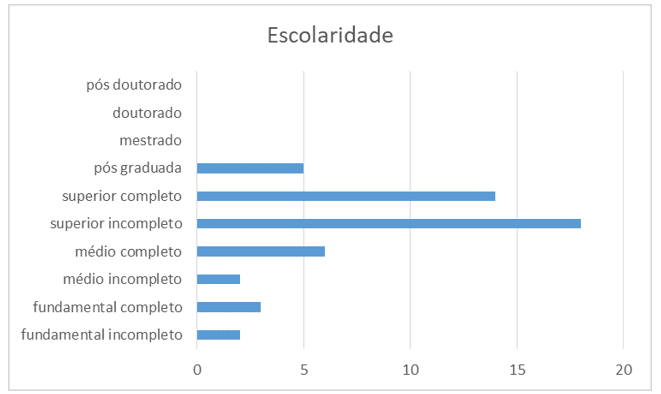
Source: Araújo; Fagundes; Souza (2019)
According to Graph 01, it is concluded that, despite the occupation, even so, Uruaçu women manage to dedicate themselves to studies, since 26% of the interviewees have already completed higher education and 36% have incomplete higher education. which demonstrates women’s willingness to train for the job market.
In addition, the IBGE’s social indicators, published in 2016, showed a general trend towards an increase in women’s education in relation to men, which quantifies that women reach a higher level of education when compared to men. Also according to the publication, 13.5% of men aged 25 or over have higher education, while this figure is higher for women with 16.9% (IBGE, 2016).
Graph 02: Marital status
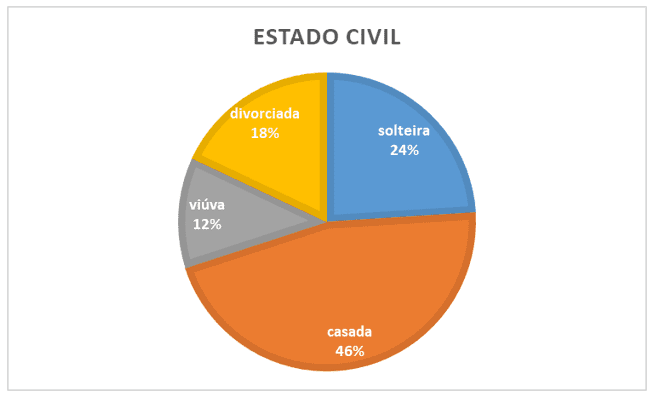
Source: Araújo; Fagundes; Souza (2019)
Observing graph 02, the heterogeneous character of the research is evident, as women from different marital status were interviewed, from single to widow. Thus, according to the data collected, it was noted that, regardless of marital status, with rare exceptions, double working hours are present.
In relation to race/color, it was found that 44% of the interviewees declared themselves to be brown, then white, adding up to 26% and 18% who declared themselves to be black. In addition to 10% declaring themselves yellow and only 2% indigenous, according to graph 03.
The data found in the research, as shown in graph 03, do not corroborate the data published by the last census carried out by the IBGE (2019), which found that 49% of the Brazilian population self-declare as white and only 13.6% self-declare as brown.
Graph 03: Race/Color
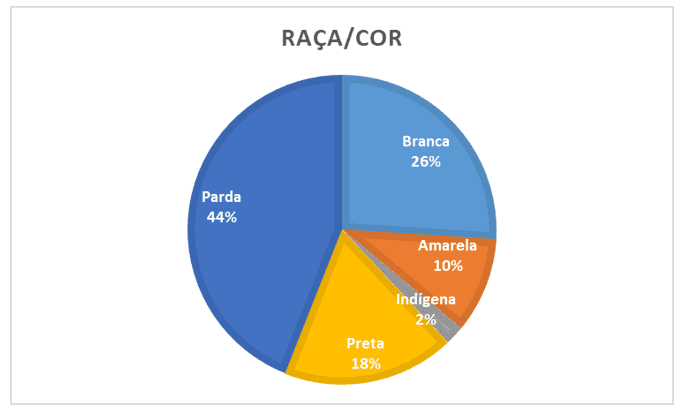
Source: Araújo; Fagundes; Souza (2019)
Regarding the main question of the study on the theme of women’s double shifts, that is, the women’s alternation between domestic activities at home and paid work outside the home, it was initially asked whether the interviewees had a job outside the home. home, to which the answer was obtained that 96% of the interviewees had a job.
Graph 04: Work outside the home environment
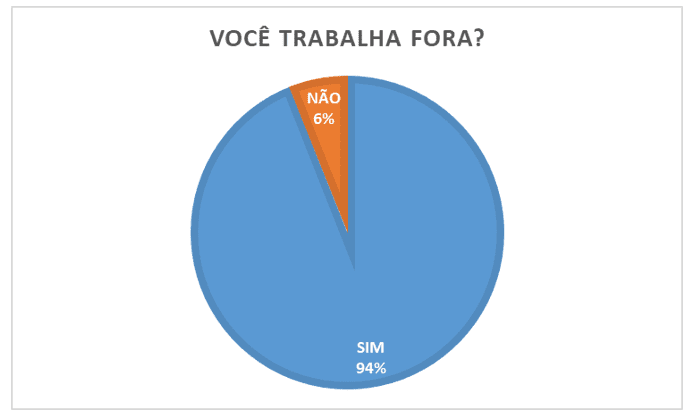
Source: Araújo; Fagundes; Souza (2019)
The data obtained were different from those published by a survey carried out by the IBGE (2008) in the main capitals of the country: Recife, Salvador, Belo Horizonte, Rio de Janeiro and São Paulo, carried out in 2008, which resulted in a percentage of 43.1% of the interviewed women have a job outside the home, which demonstrates that despite the sample difference, Uruaçu women are more inserted in the market.
In view of the data presented, it is not known which factors lead the woman from Uruaçu to the job market, since the psychologist Zimeo (2012) listed the three factors that motivate women to work: personal, professional fulfillment or financial need.
when asked about household chores and whether the responsibility for them was only the woman’s or shared by someone else, 73% of the interviewees answered that they were only responsible for the household chores, according to graph 5. That is, they do not have anyone’s help at home. On the other hand, the few who answered counting on someone’s help mentioned their husband, children and day laborer to share this responsibility.
It is clear from this that they were unable to disconnect from the functions and tasks of the home, even working outside the home, which caused them to become overloaded and more responsibilities.
With this it can be deduced that according to Detoni; Lages and Sarmento (2015), “working outside the home” was one of the ways found to guarantee new spaces of action, not managing, however, to discard “working inside the house”, the price for so much motivation for emancipation has been high. (DETONI; LAGES and SARMENTO, 2015, p. 3).
Graph 05: Responsibility for household chores.
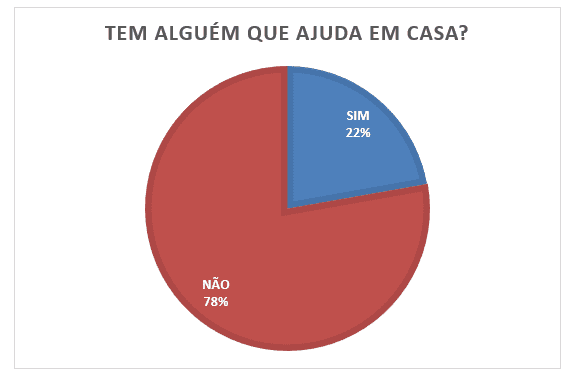
Source: Araújo; Fagundes; Souza (2019)
Regarding this division of responsibility for household chores, IPEA (2008) shows that it is a cultural issue that women are responsible for the house. In addition, she states that when men help them in this task, they are responsible only for less complex tasks, such as shopping at the supermarket or taking children to school. This results in an extra working week of 7.5 hours per week for women.
As is well known, women are less valued financially in the job market, so it was asked whether the interviewees earned more or less than their partners. In response, it was found that 86% of the interviewees stated that they received less than their partner.
Graph 06: Salary discrepancy between men and women.
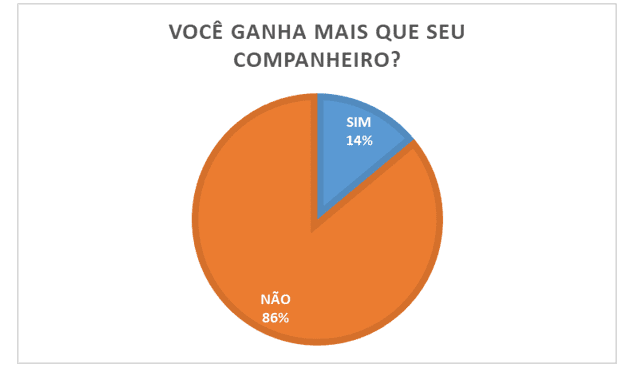
Source: Araújo; Fagundes; Souza (2019)
Despite this reality of discrepancy between men’s and women’s wages, since 2016, this difference has decreased, since women’s wages rose by 2.6%, while in the same year, men’s rose by only 1.8%. But it is still not ideal, as women earn 85.1% of men’s wages. Which translates into a national average salary of BRL 2,708.71 for women and BRL 3,181.87 for men, according to data from Agência Brasil (2018).
Even in the midst of this duality of longer working hours and lower pay, women still consider themselves independent. These data were glimpsed both in the current research, which found that 80% of the interviewees consider themselves independent, according to graph 07.
Graph 07: Independence of women
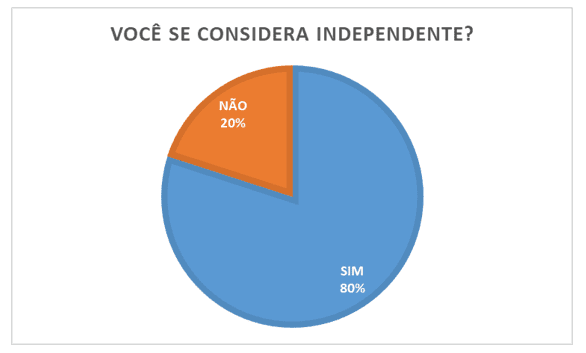
Source: Araújo; Fagundes; Souza (2019)
Finally, the interviewees were asked if they felt happy because they were women. A result of 78% of the interviewees was obtained if they consider themselves happy. It was also asked, subjectively, the reason why the interviewees felt happy or not because they were women.
Most of the interviewees who answered in the affirmative related this happiness to the fact of being able to form a family through motherhood. On the other hand, those who responded negatively related to the reason for the devaluation of women, which is often not recognized in the face of all the duties performed.
5. FINAL CONSIDERATIONS
It can be concluded, then, that culturally, women have always been responsible for the numerous tasks known collectively as “household tasks”, for this reason, the term double shift is attributed, since the woman needs to reconcile these tasks with paid work.
In general, Brazilian social thought, with regard to the position of women, is still rooted in the big house and slave quarters. And it is in this context that conflicts arise in an attempt to link unpaid work and paid work, as women have advanced in the labor market and, on the other hand, men are still far behind in the domestic sphere.
Through the data collected, it was noticed that this reality is also inserted in the municipality of Uruaçu, since the women from Uruaçu work outside the home, are responsible for household chores, have a considered level of education and, even so, earn less than the men.
Even with all the historical context of evolution, arising from the various struggles of women, which culminated in the insertion of equality, provided for in the Brazilian Constitution of 1988, in its Art. 226, which prays for the equality of rights and duties of men and women in relation to the conjugal society and places family planning as a right to be exercised by the couple (BRASIL, 1988).
However, it is important to note that this legal prerogative still does not guarantee real equality between men and women, especially with regard to the double working day assigned only to women.
In view of the above, it is noted that “working outside the home” was one of the ways found to guarantee new spaces of action, not managing, however, to discard “work inside the house”, the price for so much motivation for emancipation has been high.
However, greater investments are needed in public policies in order to guarantee labor valorization, even in terms of social security rights, since this amount of hours worked is not accounted for for retirement purposes.
It should be noted that this research is not intended to exhaust the subject, but so that there is greater interest in researching and deepening the topic in question, serving as an incentive for the emergence of new research inherent to this theme.
REFERENCES
BANDEIRA, Lourdes; Thurler, Ana Liési. A vulnerabilidade da mulher à violência doméstica: aspectos históricos e sociológicos. 2010.
BARBOSA, Esdras da Silva. Ensino de História e RAP: classe, raça e gênero como possibilidades de diálogo nas aulas de História. 2017. Monografia – Universidade de Brasília. Brasília, 2017. Disponível em: https://bdm.unb.br/bitstream/10483/18889/1/2017_EsdrasdaSilvaBarbosa.pdf Acesso em: 18/05/2019
BARROCAL, André. Mulheres Trabalham 7,5 horas a mais que os homens. Carta Capital. São Paulo, 6 de maio de 2019. Disponível em: http://www.cartaeducacao.com.br/aulas/medio/a-dupla-jornada-das-mulheres/ Acesso em: 13/03/2019.
BARROS, Alice Monteiro de. Curso de Direito do Trabalho. São Paulo. 2010, 67.
BEAUVOIR, Simone. O segundo sexo. São Paulo: Difel-Difusão Europeia Do Livro, 1960.
BOURDIEU, Pierre. A dominação masculina. Trad. Maria Helena Kühner. Rio de Janeiro: Bertrand Brasil, 1999.
BRASIL. Constituição (1988). Constituição da República Federal do Brasil. Brasília, DF: Senado Federal, 1988
IBGE. Síntese de Indicadores Sociais (SIS) – Uma análise das condições de vida da população brasileira 2015. Disponível em: Disponível em: https://agenciadenoticias.ibge.gov.br/agencia-sala-de-imprensa/2013-agencia-de-noticias/releases/24266-mulheres-dedicam-mais-horas-aos-afazeres-domesticos-e-cuidado-de-pessoas-mesmo-em-situacoes-ocupacionais-iguais-a-dos-homens Acesso em 25 maio de 2019
IBGE. Pesquisa Nacional por Amostra de Domicílio. 2011
IBGE. Pesquisa Nacional por Amostra de Domicílio. 2019.
IPEA. Instituto de Pesquisa Econômica Aplicada. 2015. Disponível em:
www.ipea.gov.br-;
IBGE. Diretoria de Pesquisas Coordenação de Trabalho e Rendimento Pesquisa de Orçamentos Familiares 2007-2008. Disponível em: https://biblioteca.ibge.gov.br/visualizacao/livros/liv101670.pdf
IBGE. Diretoria de Pesquisas Coordenação de Trabalho e Rendimento Pesquisa de Orçamentos Familiares 2007-2008
DETONI, Carolina; LAGES, Sônia Regina Corrêa; SARMENTO, Sandra Carrato. OPreço da Emancipação Feminina – Uma reflexão sobre o estresse gerado pela dupla jornada de trabalho. Disponível em:<http://portal.estacio.br/media/3345423/8-opreco-emancipacao-feminina-reflexao-sobre-estresse-gerado-dupla-jornadatrabalho.pdf>. Acesso em: 09 mar. 2019.
DICIONÁRIO PRIBERAM DA LÍNGUA PORTUGUESA [em linha], 2008 2013. Disponível em:< https://dicionario.priberam.org/escrava> Acesso em 22-04-2019.
GIL, Antônio Carlos Métodos e técnicas de pesquisa social. 6. ed. – São Paulo: Atlas, 2008.
LAKATOS, Eva Maria; MARCONI, Marina de Andrade. Fundamentos de metodologia científica. 5. ed. São Paulo: Atlas, 2003.
LADEIRA, Kátia de Freitas. Dupla jornada da mulher e qualidade de vida: a influência do nível socioeconômico nas estratégias de conciliação entre o tempo laboral e o tempo familiar. Dissertação (Mestrado em Economia Doméstica) – Universidade Federal de Viçosa, Viçosa, 2000.
MARTINS, Clitia Helena Backx. Dupla jornada de trabalho: desigualdade entre homens e mulheres. Carta de Conjuntura FEE. Porto alegre, ano 22, nº04, 2013. Disponível em: <http://carta.fee.tche.br/article/dupla-jornada-de-trabalho-desigualdade-entre-homens-e-mulheres/acessado> Acesso em: 04/04/2019.
MATOS, Maria Izilda; BORELLI, Andrea. Espaço feminino no mercado produtivo. In: PINSKY, Carla Bassanezi; PEDRO, Joana Maria (orgs.). Nova História das Mulheres no Brasil. São Paulo: Editora Contexto, 2012, p. 126-14
PINHEIRO, Luana Simões. O trabalho nosso de cada dia: determinantes do trabalho doméstico de homens e mulheres no Brasil. 2018. 329f. Tese – (Doutorado em Psicologia) Universidade de Brasília. Brasília, 2018.
PRIORI, Mary Del (ORG). História das mulheres no Brasil. São Paulo, SP. Editora Pinsky, 2004.
SAKAMOTO, Leonardo. Reforma seria diferente se mulheres fossem 50% e não 15% da Câmara? Blog do Sakamoto. São Paulo, 20 de fev. de 2019. Disponível em: <https://blogdosakamoto.blogosfera.uol.com.br/2019/02/28/reforma-da-previdencia-considera-a-dupla-jornada-de-trabalho-das-mulheres/?> Acesso em: 12/05/2019
SCOTT, Ana Silvia. O caleidoscópio dos arranjos familiares. In: PINSKY, Carla Bassanezi; PEDRO, Joana Maria (Orgs.). Nova História das Mulheres no Brasil. São Paulo: Contexto, 2012. p. 15-42. SCOTT, Joan W. A mulher trabalhadora. In: DUBY, Georges; PERROT, Michelle (Orgs.). História das mulheres no Ocidente. Porto: Edições Afrontamento, vol. IV, 1991. p. 443-475.
SILVA, Christiane Leolina Lara; ARAÚJO, José Newton Garcia de; MOREIRA, Maria Ignez Costa; BARROS, Vanessa Andrad. O trabalho de empregada doméstica e seus impactos na subjetividade. Psicologia em Revista. Belo Horizonte, v. 23, n. 1, 2017. Disponível em: < http://pepsic.bvsalud.org/scielo.php?script=sci_arttext&pid=S1677-11682017000100028> Acesso em: 21/05/2019
SÍNTESE DE INDICADORES SOCIAIS. Uma análise das condições de vida da população brasileira: 2020. IBGE, Coordenação de População e Indicadores Sociais. – Rio de Janeiro: IBGE, 2020. 148 (Estudos e Pesquisas. Informação Demográfica e Socioeconômica, ISSN 1516-3296; n. 43)
ZIMEO, Adélia Ester Maame. Anseios da Vida. 2012. São Paulo. Disponível em: https://www.blogger.com/profile/00388036168290317588
APPENDIX – FOOTNOTE REFERENCE
4. Slave: Captive woman. Which is dominated by an idea or feeling = dependent; An individual who has been deprived of his freedom and who lives in absolute subjection to someone who treats it as an exploitable and negotiable asset. A woman who is subject to radical submission to any man; overworks without pay.
5. Síntese de Indicadores Sociais.
6. Instituto de Pesquisa Econômica Aplicada.
[1] Postgraduate student in Civil Law – PUC-Minas; Postgraduate in Biology from UFLA; Postgraduate in Environmental Management from FASEM; postgraduate degree in Teaching Methods and Techniques at UNIVERSO; Law student at UEG; Graduated in Physics from UFG; Graduated in Biology from UEG; Graduated in Pedagogy from UEG.
[2] Postgraduate in Higher Education Teaching- UEG/ Uruaçu- GO; Postgraduate in Public Management/ UEG/ Uruaçu-GO. Degree in History – GO; Graduating in Bachelor of Laws- UEG/ Uruaçu-GO.
[3] Graduation in Physiotherapy – State University of Goiás. Postgraduate in Health Management – State University of Goiás. Graduate student in Law – State University of Goiás. Postgraduate student in Labor Law and Labor Process – Instituto Verbo Jurídico.
Sent: June, 2021.
Approved: November, 2021.



